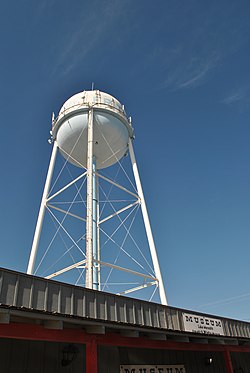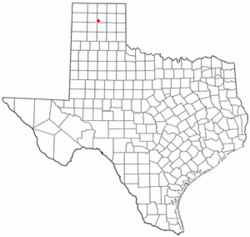Fritch, Texas
Fritch, Texas | |
|---|---|
 Fritch water tower | |
 Location of Fritch, Texas | |
 | |
| Coordinates: 35°38′35″N 101°35′47″W / 35.64306°N 101.59639°W | |
| Country | United States |
| State | Texas |
| Counties | Hutchinson, Moore |
| Area | |
• Total | 1.62 sq mi (4.20 km2) |
| • Land | 1.62 sq mi (4.20 km2) |
| • Water | 0.00 sq mi (0.00 km2) |
| Elevation | 3,189 ft (972 m) |
| Population (2020) | |
• Total | 1,859 |
| • Density | 1,100/sq mi (440/km2) |
| Time zone | UTC-6 (Central (CST)) |
| • Summer (DST) | UTC-5 (CDT) |
| ZIP code | 79036 |
| Area code | 806 |
| FIPS code | 48-27696[3] |
| GNIS feature ID | 2410550[2] |
| Website | www |
Fritch is a city in Moore and Hutchinson Counties, Texas, United States. The population was 1,859 at the 2020 census.[4]
History
[edit]1992 tornado
[edit]On June 27, 1992, a mile-wide, multi-vortex F4 tornado struck the Fritch area, resulting in major damage to the city and seven injuries, but no loss of life.[5]
2014 wildfire
[edit]On May 11, 2014, a fast-moving wildfire in the area began, causing much destruction and loss of homes in the Fritch area, which was evacuated by authorities. Media reported 100 structures destroyed with numerous people in local shelters.[6][7]
Geography
[edit]Fritch is located in the southwest corner of Hutchinson County[8] at the geographic center of the Texas Panhandle region. It is 35 miles (56 km) north-northeast of Amarillo and 13 miles (21 km) west of Borger. Fritch sits in an area where the typically flat High Plains are divided into canyons and draws by the Canadian River. The city sits on flat land surrounded by undulating terrain.
Lake Meredith on the Canadian River lies 2 miles (3 km) northwest of the city and is a main source of water for surrounding communities, though Fritch uses water drawn from the Ogallala Aquifer for its municipal supply.
Demographics
[edit]| Census | Pop. | Note | %± |
|---|---|---|---|
| 1960 | 1,617 | — | |
| 1970 | 1,778 | 10.0% | |
| 1980 | 2,299 | 29.3% | |
| 1990 | 2,335 | 1.6% | |
| 2000 | 2,235 | −4.3% | |
| 2010 | 2,117 | −5.3% | |
| 2020 | 1,859 | −12.2% | |
| U.S. Decennial Census[9] | |||
2020 census
[edit]| Race | Number | Percentage |
|---|---|---|
| White (NH) | 1,588 | 85.42% |
| Black or African American (NH) | 7 | 0.38% |
| Native American or Alaska Native (NH) | 20 | 1.08% |
| Asian (NH) | 4 | 0.22% |
| Some Other Race (NH) | 3 | 0.16% |
| Mixed/Multi-Racial (NH) | 102 | 5.49% |
| Hispanic or Latino | 135 | 7.26% |
| Total | 1,859 |
As of the 2020 United States census, there were 1,859 people, 824 households, and 616 families residing in the city.
2000 census
[edit]As of the census[3] of 2000, 2,235 people, 886 households, and 679 families resided in the city. The population density was 1,840.9 inhabitants per square mile (710.8/km2). The 961 housing units averaged 791.5 units per square mile (305.6 units/km2). The racial makeup of the city was 95.53% White, 0.09% African American, 1.66% Native American, 0.13% Asian, 1.30% from other races, and 1.30% from two or more races. Hispanics or Latinos of any race were 4.30% of the population.
Of the 886 households, 34.7% had children under the age of 18 living with them, 66.3% were married couples living together, 8.1% had a female householder with no husband present, and 23.3% were not families. About 21.6% of all households were made up of individuals, and 11.7% had someone living alone who was 65 years of age or older. The average household size was 2.52 and the average family size was 2.93.
In the city, the population was distributed as 26.4% under the age of 18, 7.5% from 18 to 24, 25.8% from 25 to 44, 24.0% from 45 to 64, and 16.4% who were 65 years of age or older. The median age was 39 years. For every 100 females, there were 98.1 males. For every 100 females age 18 and over, there were 93.6 males.
The median income for a household in the city was $42,098, and a family was $46,600. Males had a median income of $41,134 versus $21,860 for females. The per capita income for the city was $17,745. None of the population were below the poverty line.
Fritch is primarily a bedroom community, with the majority of citizens commuting to nearby Borger and Amarillo for work. Major employers in the area include Pantex, ConocoPhillips, and Agrium, all located within a short distance of Fritch. Due to its nature as a commuting town, Fritch differs from most small towns in the region, which rely more on agriculture as their economic base. Though several large ranches are adjacent to the town, little to no farming occurs due to the uneven topography, and the town has few agriculture-related services.
Recreation
[edit]Fritch is located adjacent to the Lake Meredith National Recreation Area, which offers residents and visitors ample opportunities for outdoor activities including boating, fishing, camping, hiking, and seasonal hunting. Alibates Flint Quarries National Monument is 10 miles (16 km) southwest of Fritch along Lake Meredith. The city is home to the Lake Meredith Historical Museum.
Notable people
[edit]- John LaGrone (1944–2022), American football player and judge
- Krum (born 1977), rapper
- Ron White (born 1956), comedian
Education
[edit]Fritch is served by the Sanford-Fritch Independent School District.
Images
[edit]-
Rattlesnake Island in Lake Meredith
-
Sunrise near Fritch, TX
-
Fritch Fortress boat ramp on Lake Meredith
-
Canadian River wetlands near Fritch, TX
References
[edit]- ^ "2019 U.S. Gazetteer Files". United States Census Bureau. Retrieved August 7, 2020.
- ^ a b U.S. Geological Survey Geographic Names Information System: Fritch, Texas
- ^ a b "U.S. Census website". United States Census Bureau. Retrieved January 31, 2008.
- ^ a b "Explore Census Data". data.census.gov. Retrieved May 20, 2022.
- ^ Davidson, Sarah (April 20, 2007). "Fritch Tornado of 1992". KVII. Retrieved June 19, 2022.
- ^ "UPDATE Fire has destroyed roughly 100 homes". Archived from the original on May 12, 2014. Retrieved May 12, 2014.
- ^ "Hutchinson County LEPC Facebook updates". Facebook. Retrieved May 12, 2014.
- ^ "US Gazetteer files: 2010, 2000, and 1990". United States Census Bureau. February 12, 2011. Retrieved April 23, 2011.
- ^ "Census of Population and Housing". Census.gov. Retrieved June 4, 2015.
- ^ https://www.census.gov/ [not specific enough to verify]
- ^ "About the Hispanic Population and its Origin". www.census.gov. Retrieved May 18, 2022.






